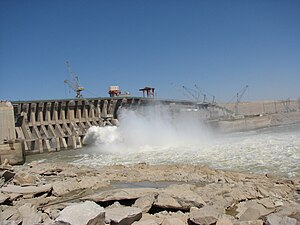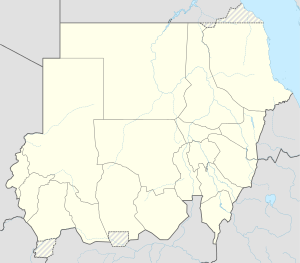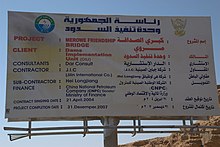Merowe Dam
| Merowe Dam | |||||||||
|---|---|---|---|---|---|---|---|---|---|
| Merowe Dam | |||||||||
|
|||||||||
|
|
|||||||||
| Coordinates | 18 ° 40 ′ 8 ″ N , 32 ° 3 ′ 1 ″ E | ||||||||
| Data on the structure | |||||||||
| Construction time: | 2000-2008 / 09 | ||||||||
| Height of the barrier structure : | 67 m (CFRD); 52 m (Erdkerndamm) | ||||||||
| Building volume: | 16.1 million m³ | ||||||||
| Crown length: | 9200 m | ||||||||
| Slope slope on the air side : | 1: 1.6 (CFRD); 1: 1.8 (Erdkerndamm) | ||||||||
| Slope slope on the water side : | 1: 1.3 (CFRD); 1: 2 (Erdkerndamm) | ||||||||
| Power plant output: | 1250 MW | ||||||||
| Data on the reservoir | |||||||||
| Altitude (at congestion destination ) | 280.50 m | ||||||||
| Water surface | 476 km² | ||||||||
| Storage space | 12,500 million m³ | ||||||||
| Catchment area | 2.87 million km² | ||||||||
| Design flood : | 20,000 m³ / s | ||||||||
The Merowe Dam , also Hamdab High Dam, is a dam in Sudan . The dam is located on the Nile below the fourth cataract , about 350 km north of Khartoum and 40 km upstream of the city of Merowe .
Reservoir
The reservoir extends from the dam near Hamdab to west of the city of Abu Hamad . Before completion, the reservoir was estimated to be 170 to 200 km long, with a storage space of 12.5 billion m³, a surface of 476 km² and an average depth of 26 m. The catchment area is 2.87 million km².
dam
The dam is a total of 9200 m long, up to 67 m high and consists of different parts:
- a 311 m long homogeneous earth dam on the right side,
- a 4364 m long main embankment made of rubble with a concrete surface ( CFRD ) on the right,
- a 154 m long flood overflow and a 370 m long power plant inlet structure on the right channel and at Marwa Island,
- an 841 m long stone embankment with an earth core on the left side,
- a 1,437 m long CFRD dam on the left,
- a 1700 m long earth dam on the left.
Hydroelectric power plant
The hydropower plant at the foot of the dam has ten Francis turbines with a nominal output of 1,260 MW (based on the nominal output of the generators). With a head of 43 m, each turbine has an additional flow rate of 300 m³ / s. The standard capacity is (d. H. 630 MW) at a load factor of 50 percent to an annual estimated 5500 GWh. It will roughly double the current Sudanese electricity production. The apparent power of the ten identical generators is 140 MVA, the active factor is 0.90, the nominal voltage is 13.8 kV, the required nominal speed is 100 / min, this results in a number of pole pairs p = 30. Due to the high number of pole pairs, the machines have a large diameter. The entire system includes the construction of a total of around 1000 km of electricity transmission lines through the Bayuda Desert to Khartoum and Port Sudan as well as to the neighboring towns of Merowe and Dunqula . Electricity generation began in early March 2009.
irrigation
Another positive effect is planned, in addition to generating electricity, to divert water through 400 km long canals and make it usable for agricultural irrigation. An arid area of around 400,000 hectares is to be turned into fertile farmland.
contractor
Several foreign companies are involved in the project as contractors:
- China International Water & Electric Corp. and China National Water Resources and Hydropower Engineering Corp .: dam construction works, hydromechanics.
- Lahmeyer International (Germany): planning, project management, civil engineering work.
- Alstom (France): generators, turbines.
- Harbin Power Engineering Company and Jilin Province Transmission and Substation Project Company (China) signed a $ 460 million contract to build power transmission lines.
The donors are four banks from Arab states and the China Exim Bank, which together provided 850 million US dollars. The total construction cost is estimated at $ 1.8 billion and funded by the China National Petroleum Corporation . The state-owned Chinese oil company is also financing the expansion of roads in Sudan. In addition to the Merowe Dam project, it financed the construction of the first bridge over the Nile in Sudan north of the capital with $ 10 million. The bridge was built by Chinese companies, inaugurated in January 2008 and connects the two towns of Merowe and Karima . Investments in infrastructure, increasingly carried out by Chinese companies since around 2000 in connection with oil production or dam projects, are received positively by the population as development aid and strengthen the influence of the Chinese economy in general in the country.
Cons and protests
The dam project is controversial. Thousands of people have already had to flee before the rising water of the reservoir, it is estimated that 50,000 will have to be relocated from the fertile Nile valley to the barren Nubian desert (see e.g. Dar al-Manasir ). Archaeological sites from 5,000 years ago are or have already been flooded.
Protests against the dam resulted in at least three deaths in April 2006. Between August 2006 and January 2009, the reservoir was dammed and 100 families had to give up their houses without any information or warning from the authorities. According to reports, the victims received no support after their displacement, were temporarily without food and shelter and in some cases became permanently homeless. The UN special rapporteur on the human right to adequate housing therefore called in August 2007 for construction to be halted on the Merowe and Kajbar dams until an independent investigation into the allegations could be carried out.
At the beginning of October 2008 the locks on the dam were closed. Part of the local population above the dam continued to protest and tried to protect themselves against the rising waters of the Nile in the settlements. 30,000 people are said to have been displaced so far. In July 2008, foreigners and journalists were banned from entering the area.
In May 2010 a complaint was brought against Lahmeyer International for "causing a flood" in Frankfurt am Main.
Chinese nuclear waste is also said to have been secretly disposed of during the construction of the Merowe Dam . The head of the Sudanese Atomic Energy Agency confirmed to parliament in November 2015 that between 2004 and 2009, 60 barrels of nuclear waste had been brought from China to Sudan and buried in the desert near Merowe. Local politicians and gold miners had previously reported a sharp increase in cancer and skin diseases. Some reports mention up to 500 nuclear waste cans in different places in northern Sudan.
Installation
The dam reached its intended water level in January 2009. The first two turbines went into operation at the beginning of February. These two turbines began producing electricity in March. According to the Sudanese government, the last two turbines went online on schedule in April 2010.
See also
- List of power plants in Sudan
- List of dams in the world (Sudan)
- List of dams on the Nile
- List of the largest dams on earth
- List of the largest reservoirs on earth
- List of the largest hydroelectric plants in the world
Web links
- Official website
- Merowe Dam and Hydroelectric Power Plant
- Merowe Dam
- Case Study Merowe / Hamdad Dam Project. ETH Zurich, July 16, 2007 (PDF; 497 kB) Comprehensive project study
- Criticism of the International Rivers Network on the Merowe Dam
Individual evidence
- ↑ Ali Askouri: China's investment in Sudan: destroying communities. Pambazuka News, December 14, 2006
- ↑ Vivien Foster, William Butterfield et al. a .: Building Bridges. China's Growing Role as Infrastructure Financier for Sub-Saharan Africa. World Bank, Washington 2008, p. 50
- ^ World Organization Against Torture: Sudan. Ongoing violence against communities resisting dam construction in the northern nile valley. Geneva, November 30, 2007
- ↑ UN News Center: UN rights expert urges suspension to dam projects in northern Sudan.
- ↑ Merowe dam floods thousands in area closed to outsiders. Sudan Tribune, October 3, 2008
- ↑ Flood for morning prayer. Frankfurter Rundschau, May 12, 2010 and: Construction project in Sudan: Human rights activists report German company to dam flooding. Spiegel Online, May 4, 2010
- ↑ http://www.taz.de/Atomkraft-in-Afrika/!5304451/
- ^ DIU Celebrates the Running of Merowe First and Second Turbines. Project's News, Merowe Dam Project, February 6, 2009 Depiction of the Sudanese government
- ↑ Merowe Electricity Generation to be launched 3rd March 2009. Sudan Online, News & Information Center, February 8, 2009 ( Memento of February 13, 2009 in the Internet Archive )
- ^ The Higher Committee Reviews Preparations for Celebrating Last Two Units. Project's News, Merowe Dam Project, April 1, 2010


